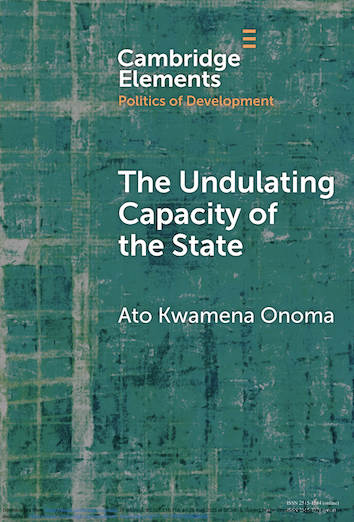New Book Release: The Undulating Capacity of the State by Ato Kwamena Onoma

In The undulatingcapacity of the state I explore why African states implement largescaleinfrastructure projects with ease in some urban neighborhoods while strugglingto do so in others. The urban landscape of Dakar where the Senegalese statedemonstrated varying level of ease in constructing segments of the VDN 2 (Voie de dégagement nord 2) highway between 2017 and 2022 serves asthe terrain for this work.
Exploring this case of largescaleinfrastructure development allows me to center the major question of theAfrican state along with its capacity and will to undertake the work ofdevelopment that has been a major preoccupation in the study of Africanpolitical economy. The African landscape today is dotted with impressive new largescalephysical infrastructure including highways, railways, stadia, housing estates,dams and whole new cities. Unfortunately, these are often shadowed by a plethoraof uncompleted, long overdue and outrightly jettisoned infrastructure projects.Thus, while majestic infrastructural realizations undercut the Afropessimistliterature that casts the African state as (inherently) lacking indevelopmental ambition and capacity, states’ struggles at implementing similarprojects act as a haunting reminder of concerns about state’s ability to makeand implement policies, corruption, poor prioritization and over-indebtedness.
I argue that in Africancities that were founded and/or initially developed under colonial control differingclaims to belonging in cities across neighborhoods impacts the ability ofstates to undertake development work, including largescale infrastructuredevelopment. Historical struggles over colonial and postcolonial states’confiscation of lands have created acute political distrust in neighborhoodsthat cast themselves as autochthonous in these cities. This elevated level ofdistrust leads to extreme skepticism over state developmental intentions, the advocacyof zero-risk project design and insistence on the delivery of compensation and inducementsbefore project design making infrastructure development extremely costly andtime-consuming. In those neighborhoods that are largely made up of new arrivalsin these cities, the absence of histories of land expropriation targeting thesecommunities has left a legacy of higher levels of trust in the state as adevelopmental agent. Members of these communities tend to be more embracing ofstate development narratives, are more tolerant of risks associated withinfrastructure projects and more accepting of compensation and inducementsafter the completion of development projects. All of this makes it easier forthe state to undertake infrastructure development in these migrant neighborhoods.It is this difference between Cambérène, which casts itself asautochthonous and Parcelles Assainies, which celebrates its character as amelting pot of new migrants that explains the Senegalese state’s challengeswith building the VDN 2 along the coast of the former neighborhood compared tothe ease with which it did so on the coast of the latter.
A major contribution ofthis Element is my demonstration of how insights from flourishing literatureson autochthony and on African cities can shed light on varying levels of politicaltrust, which is widely recognized in the literature to influence a range ofpolitical economic outcomes, including the capacity of the state to undertakedevelopment work.
Going beyond thetendency in the literature to juxtapose political dynamics in rural and urbanspaces, I demonstrate the rewards that can be reaped from a more nuancedapproach that traces historically rooted divergences across the same urbanlandscape. Unearthing the differences that mark neighborhoods in the same urbanarea allows us to better map and explain the varying ability of the state toundertake development work by affording the researcher a multiplicity of caseswhose similarity on multiple counts allows for more robust internal validity incausal analysis.
By shinning a light on howbroad historically rooted struggles over land rights and questions of belonginginfluence the success of largescale infrastructure development, I show thelimits of recommendations for enhancing the success of these projects thatfocus on narrow project parameters, including improved and more participatory design,transparent accounting, and greater benefits for local communities. I show how distrustrooted in broader historical struggles can undermine even well-meaning andserious efforts by states to implement these recommendations that are advocatedby development agencies and civil society organizations alike. Unravelling theuneven journey of the Senegalese states’ VDN 2 construction efforts on theoutskirts of Dakar, I argue that engaging with broader issues of rights andsocial justice whose roots lie in the colonial and postcolonial elaboration ofthe state is critical to boosting the capacity of the state to positively reshapeits territory.
Ato Kwamena Onoma is a Professor of Political Science at the University of Toronto


.svg)

.svg)